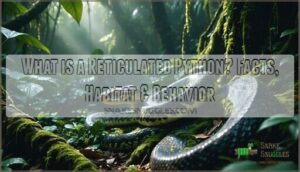This site is supported by our readers. We may earn a commission, at no cost to you, if you purchase through links.
 A 28-foot snake coiled in the shadows of a Sumatran rainforest doesn’t just hunt—it calculates. The reticulated python, Southeast Asia’s top constrictor, combines infrared vision with muscular precision to ambush prey ranging from rats to deer. Its distinctive diamond-patterned scales, which inspired its scientific name Malayopython reticulatus, create near-perfect camouflage in dappled forest light.
A 28-foot snake coiled in the shadows of a Sumatran rainforest doesn’t just hunt—it calculates. The reticulated python, Southeast Asia’s top constrictor, combines infrared vision with muscular precision to ambush prey ranging from rats to deer. Its distinctive diamond-patterned scales, which inspired its scientific name Malayopython reticulatus, create near-perfect camouflage in dappled forest light.
Yet despite its "Least Concern" conservation status, these splendid predators face mounting pressure from deforestation and wildlife trafficking across their 13-country range. Understanding what makes reticulated pythons both formidable hunters and vulnerable survivors reveals how evolution shapes predators—and how quickly human activity can unravel millions of years of adaptation.
Table Of Contents
- Key Takeaways
- What is a Reticulated Python?
- Reticulated Python Habitat and Range
- Diet and Hunting Behavior
- Reproduction and Life Cycle
- Conservation Status and Human Interaction
- Frequently Asked Questions (FAQs)
- What makes a python reticulated?
- Has a reticulated python ever killed a human?
- What eats reticulated pythons?
- Is a reticulated python a good pet?
- How fast can a reticulated python move?
- What diseases commonly affect reticulated pythons?
- How long do reticulated pythons live?
- Can reticulated pythons recognize their owners?
- Do reticulated pythons hibernate during winter months?
- How do reticulated pythons defend themselves from predators?
- Conclusion
Key Takeaways
- Reticulated pythons are Southeast Asia’s longest constrictors, reaching up to 28.5 feet, using infrared pit organs and diamond-patterned camouflage to ambush prey from rats to deer with calculated precision.
- Despite their "Least Concern" conservation status, these pythons face severe threats from deforestation that’s eliminated 40% of their natural habitat since 2000 and illegal wildlife trade exporting 350,000 skins annually.
- Their remarkable adaptability allows survival across fragmented habitats from rainforests to urban edges, though population declines are documented across their 13-country range due to habitat loss and exploitation.
- These apex predators play a critical ecosystem role controlling prey populations across forest layers, but their survival now depends on habitat corridor preservation and combating wildlife trafficking before local extinctions become irreversible.
What is a Reticulated Python?
The reticulated python—Malayopython reticulatus—stands as one of the world’s longest snakes, a powerful constrictor that can exceed 20 feet in length. You’ll find these exceptional serpents across Southeast Asia, where their distinctive diamond-patterned scales have earned them a name meaning "network."
Before we explore their classification, naming, and physical traits, let’s understand what sets these giants apart from other python species.
Scientific Classification and Taxonomy
You’ll find the reticulated python classified scientifically as Malayopython reticulatus—a name rooted in taxonomic history and genetic research. First described in 1801, this species faced phylogenetic analysis debates before landing in its current genus through evolutionary biology studies in 2014.
Snake taxonomy and classification revealed its true phylogeny: it’s closer to Australo-Papuan pythons than other Python species. Today, three subspecies exist, shaped by millions of years of species formation across Southeast Asia. The species is often studied regarding its native species range to understand its habitat and behavior.
Reticulate Definition and Name Origin
The name itself tells the story—"reticulate" comes from the Latin reticulum, meaning "net" or "network". It refers to the intricate, diamond-shaped pattern that runs along the python’s back like a living mosaic.
This morphology isn’t just beautiful—it’s your key to species identification. The network pattern weaves together black, white, yellow, and red scales in a design so distinctive that early naturalists coined the python nomenclature based purely on this anatomical feature, transforming descriptive anatomy into identity.
Unique Physical Characteristics
Beyond that striking pattern lies a body built for power—reticulated pythons regularly exceed 16 feet in length, with the largest verified specimen stretching an astounding 28.5 feet and tipping the scales at 320 pounds.
You’ll notice these morphological adaptations for predation:
- Multiple rows of recurved teeth anchor prey with unrelenting grip
- Infrared-sensitive pit organs on the lips detect thermal signatures like biological night vision
- Grayish tan scaly texture with diamond-shaped color variation creates camouflage through pattern formation
This anatomy reflects millions of years of physiology refined for constriction.
Reticulated Python Habitat and Range
You’ll find reticulated pythons spread across Southeast Asia, from the steamy rainforests to surprisingly human-altered landscapes. These adaptable giants don’t just survive in untouched wilderness—they’ve learned to thrive where forests meet farms and cities push into wild spaces.
Let’s look at where these pythons make their home and how they’ve managed to coexist with humanity’s expanding footprint.
Native Distribution in Southeast Asia
You’ll find reticulated pythons spanning at least 13 Southeast Asian countries, from Indonesia’s sprawling archipelago to the Nicobar Islands and Bangladesh. Their geographic range includes major islands like Sumatra, Borneo, Java, Sulawesi, and over 20 Philippine islands—evidence of their impressive island colonization abilities as excellent swimmers.
Regional genetics reveal distinct populations, with genetic divergence reaching 12.2% within Philippine groups alone. Conservation efforts monitor stable populations in protected areas like Indonesia’s Ujung Kulon National Park, though habitat preferences vary from tropical ecosystems to agricultural landscapes across this vast snake habitat and distribution zone. The reticulated python’s native habitats are typically found in tropical rainforests with abundant water sources.
| Region | Key Islands/Countries | Genetic Distinctiveness |
|---|---|---|
| Western Clade | Java, Sumatra, Singapore | Baseline haplotype groups |
| Eastern Clade | Sulawesi, Philippines | Up to 12.2% divergence |
| Borneo/Lesser Sundas | Kalimantan, Bali, Timor | Phylogenetically distinct |
| Mainland | Thailand, Myanmar, Vietnam | Lower genetic variation |
Adaptability to Diverse Environments
From rainforests dripping with humidity to the edges of bustling cities, reticulated pythons thrive where most large constrictors wouldn’t dare—a demonstration of their impressive ecological flexibility. You’ll encounter them in tropical ecosystems ranging from unspoiled rainforest canopies to rice paddies and suburban backyards.
Their environmental flexibility allows survival across fragmented habitats, demonstrating remarkable ecological resilience. This urban survival capacity and agricultural tolerance make reticulated python populations surprisingly sturdy despite ongoing habitat degradation throughout their range.
Habitat Requirements and Human Impact
Despite exceptional adaptability, you need to understand that reticulated python habitat depends on three critical elements now under siege from human activities.
- Water sources: Over 80% of tracked pythons stay near rivers and wetlands—zones rapidly altered by agriculture and urban sprawl
- Dense vegetation cover: Forest fragments support 60% higher python abundance than plantations, yet palm oil expansion removed 40% of natural habitat since 2000
- Climate stability: Ideal temperatures (24–34°C) and humidity above 70% are essential for survival and reproduction
Habitat fragmentation isolates populations, reducing genetic diversity. Conservation efforts must prioritize maintaining forest corridors between tropical forest patches, or wildlife habitats face irreversible degradation from human encroachment and ongoing habitat loss.
Diet and Hunting Behavior
Reticulated pythons are dominant predators that hunt using a blend of patience and precision. You’ll find these snakes relying on specialized sensory organs and powerful constriction to take down prey that ranges from small mammals to animals as large as deer.
Let’s break down how they hunt in the wild, what adaptations make them so effective, and how their diet shifts when they’re kept in captivity.
Typical Prey in The Wild
You’ll find that reticulated python prey selection shifts dramatically with age and size. Juveniles up to about 13 feet target small mammals—rats, treeshrews, and bats dominate their wild diet.
As these predators mature, they shift to heftier prey: civets, macaques, bearded pigs, even deer exceeding 130 pounds. This snake’s behavior reflects pure opportunism, adapting hunting tactics to whatever mammals, birds, or reptiles the habitat offers.
Hunting Techniques and Sensory Adaptations
Reticulated pythons don’t chase down their meals—they engineer precision ambushes using a dual-sensory system that would make any military strategist jealous. You’re witnessing infrared vision through specialized pit organs that detect heat signatures, paired with chemoreceptors tracking scent trails.
Once prey detection confirms a target, backward-curved teeth anchor victims before constriction methods—coiling pressure that stops circulation—finish the hunt. These sensory adaptations transform snake behavior from blind striking into calculated execution.
Feeding Habits in Captivity
In captivity, you’ll need to replicate the python’s wild diet with domesticated prey—think chickens, rabbits, and rats—but the feeding schedule transforms from opportunistic gorging to carefully controlled intervals. You’re balancing snake nutrition against obesity risks, rotating prey variation to prevent dietary deficiencies.
Proper enclosure management means feeding techniques that minimize stress—offering pre-killed prey prevents injury while respecting the reticulated python’s instinctive feeding habits and behavioral needs.
Reproduction and Life Cycle
Reticulated pythons follow a fascinating reproductive cycle that shapes their survival in the wild. Understanding how these giants breed, incubate their eggs, and mature into adulthood reveals the delicate balance between their biological needs and environmental conditions.
Let’s explore the key stages that define their life from mating to maturity.
Breeding and Mating Behavior
You won’t find a snake more strategic about timing than the reticulated python in terms of reproduction—sexual maturity isn’t just about age, it’s about size. Males begin their mating rituals once they’ve stretched to seven to nine feet, while females don’t breed until they reach approximately eleven feet.
This size-dependent courtship behavior means breeding seasons align with individual growth rates rather than strict age milestones, transforming reproduction into a reflection of physical prowess and survival success.
Egg-laying and Incubation Process
Once a female reticulated python has successfully mated, she’ll lay a clutch of 25 to 80 eggs.
Then, something extraordinary happens: she becomes a dedicated incubator, coiling protectively around her eggs for 80 to 90 days without eating a single meal. During this oviparous incubation period, you’ll witness her producing muscular shivers to regulate egg temperature when conditions turn cool.
Female reticulated pythons coil around their eggs for three months without eating, shivering to warm them when needed
The temperature during incubation actually determines the sex of the hatchlings—nature’s way of balancing populations through environmental cues.
Growth, Lifespan, and Sexual Maturity
After those hatchlings emerge, they face a long road to adulthood—one where survival depends on size, not just age. Males reach sexual maturity at seven to nine feet, while females don’t reproduce until hitting 11 feet—a threshold typically crossed in two to four years.
Growth patterns vary based on prey availability and environmental conditions.
In captivity, where longevity factors align favorably, you’ll see these striking constrictors thriving beyond 20 years, their aging process a testament to resilience in snake biology.
Conservation Status and Human Interaction
While reticulated pythons aren’t facing immediate extinction, their relationship with humans tells a complex story worth understanding. The International Union for Conservation of Nature lists them as least concern, but that doesn’t mean they’re free from threats.
Let’s break down what’s really happening with these extraordinary serpents regarding conservation, the dangers they face, and how they fit into both wild ecosystems and human spaces.
IUCN Status and Population Trends
Surprisingly, despite heavy exploitation, you’ll find the reticulated python listed as "Least Concern" by the IUCN—a designation rooted in its vast Southeast Asian range rather than substantial population data. Conservation status doesn’t tell the whole story, though.
Population trends reveal troubling patterns:
- Around 350,000 python skins exit Southeast Asia legally each year through wildlife trade
- Encounter rates in Borneo forests hover at just 0.051 pythons per kilometer surveyed
- Declines appear across Bangladesh, Indonesia, Malaysia, Myanmar, and the Philippines
Species management faces a critical challenge: expanded harvest zones mask local extinctions by drawing from wider areas, making habitat preservation and reptile conservation efforts increasingly urgent for this iconic constrictor.
Threats: Habitat Loss and Illegal Trade
Beyond misleading conservation status lies a harsher reality: habitat degradation from deforestation is reshaping your python’s world. Over 16.2 million hectares of Southeast Asian forests vanished between 2002 and 2022, primarily for oil palm plantations—slashing habitat suitability by 40%.
Meanwhile, wildlife trafficking intensifies the pressure. Nearly 4 million reticulated python skins left Indonesia, Malaysia, and Vietnam from 2002 to 2012, with 75% wild-caught. Snake poaching for fashion and the pet trade outpaces conservation efforts, exploiting weak monitoring systems across fragmented landscapes.
Role in Ecosystem and Captivity Considerations
As top predators, reticulated pythons control prey populations across three distinct forest layers—a balancing act now replicated (imperfectly) in zoo enclosures worldwide.
Your snake’s ecology demands complex habitat management: thermal gradients, humidity cycling, and enrichment protocols that mirror wild foraging behaviors.
Captive breeding programs advance snake conservation and wildlife education, transforming these misunderstood constrictors into ambassadors for ecosystem balance and habitat preservation.
Frequently Asked Questions (FAQs)
What makes a python reticulated?
The word "reticulate" means netlike—and that’s exactly what you’ll see when you look at this python’s back.
Their signature diamond-shaped blotches form an intricate network pattern, woven from scales in black, white, yellow, and red against a grayish tan body.
Has a reticulated python ever killed a human?
Yes—reticulated python attacks have resulted in fatal encounters with humans, though these incidents remain rare. You’re facing one of nature’s top predators here, a snake species capable of constricting prey far larger than most people realize.
Understanding snake behavior and practicing attack prevention transforms fear into respect, keeping you safer in regions where these massive serpents hunt.
What eats reticulated pythons?
You might be surprised to learn that adult reticulated pythons face few wild predators due to their size—they sit near the peak of their ecosystem’s food chain.
However, young snakes fall prey to crocodiles, birds of prey, and larger mammals, maintaining ecosystem balance.
Is a reticulated python a good pet?
Powerful predators pose particular pet care tips challenges—you’ll need massive python enclosures, expert snake management skills, and unwavering owner responsibilities.
Feeding challenges and unpredictable reticulated python behavior make these exotic pets unsuitable for most, despite conservation efforts regulating the pet trade.
How fast can a reticulated python move?
You won’t find reticulated pythons winning any speed records—these massive constrictors move at roughly 1 mph on land.
Their serpentine locomotion prioritizes stealth over velocity, relying on patient hunting tactics and ambush strategies rather than chase-down pursuits.
What diseases commonly affect reticulated pythons?
You’ll want to watch for Respiratory Issues and Bacterial Diseases in your reticulated python.
Skin Infections, Metabolic Disorders, and Parasite Control matter too—these reptiles need vigilant care to thrive in captivity and support snake conservation efforts.
How long do reticulated pythons live?
You’ll find reticulated pythons living over 20 years in captivity, where controlled conditions support their longevity.
Captive longevity exceeds wild median life expectancy, though specific age records and longevity studies remain limited for wild populations.
Can reticulated pythons recognize their owners?
Let’s cut to the chase—your reticulated python doesn’t recognize you the way a dog would. These snakes possess limited reptile cognition and lack the neural architecture for owner recognition or pet bonding.
They respond to environmental cues like warmth and feeding schedules, not emotional affinity, reflecting fundamental reticulated python behavior and animal behavior and physiology.
Do reticulated pythons hibernate during winter months?
Reticulated pythons don’t hibernate because they inhabit tropical Southeast Asian regions where temperature tolerance remains stable year-round.
Unlike temperate-zone snakes requiring winter dormancy or denning during cold climate periods, these pythons maintain consistent activity throughout all seasons in their rainforest habitat.
How do reticulated pythons defend themselves from predators?
Though silent giants rarely flee, you’ll find their survival depends on blending into shadows. Reticulated python characteristics include striking camouflage techniques—their diamond-patterned scales create natural concealment.
Defense mechanisms escalate: constrictors coil defensively, hiss loudly, and strike when threatened. These survival strategies and physical adaptations deter most predators effectively.
Conclusion
Predators protect balance, pythons preserve ecosystems. Understanding what’s a reticulated python reveals nature’s engineering—heat-sensing pits, bone-crushing coils, decades-long lifespans adapted across millennia.
Yet their survival hinges on choices you make today. Support habitat conservation, reject wildlife trafficking, demand sustainable forestry.
These diamond-scaled survivors don’t need your fear—they need your respect and action before trafficking and deforestation erase Southeast Asia’s top ambush predator forever.
- https://www.merriam-webster.com/dictionary/environment
- https://www.britannica.com/animal/reticulated-python
- https://a-z-animals.com/animals/reticulated-python/
- https://gonefroggin.com/2025/02/09/reticulated-python-malayopython-reticulatus/
- https://reptile-database.reptarium.cz/species?genus=Malayopython&species=reticulatus












